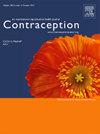Consensus recommendations for measuring the impact of contraception on the menstrual cycle in contraceptive clinical trials
IF 2.8
2区 医学
Q1 OBSTETRICS & GYNECOLOGY
引用次数: 0
Abstract
Objective
We sought to develop consensus recommendations for measurement and analysis of data on contraceptive-induced menstrual changes (CIMCs) in contraceptive clinical trials. We built upon previous standardization efforts over the last 50 years and prioritized input from a variety of global experts and current regulatory authority guidance on patient-reported outcomes.
Study design
We completed a formal consensus-building process with an interdisciplinary group of 57 experts from 30 organizations and 14 countries in five global regions who work across academia, nonprofit research organizations, the pharmaceutical industry, and funding agencies. Smaller topical working groups drafted and revised recommendations.
Results
We developed 44 consensus recommendations, including research approaches to establish the evidence for future improvement in the measurement and analysis of CIMC data and guidance for investigators to implement presently. Priority recommendations call for simplification of terminology to make measurement accessible and patient-centered, accounting for intrinsic and extrinsic factors that may impact outcomes during study design and recruitment, standardized data collection of primary CIMC and acceptability outcomes, and harmonized approaches for analysis of these data, including addressing missing data.
Conclusion
By virtually convening a large group of global experts working across disciplines and sectors via a formal methodology, we developed consensus recommendations that will improve the current and future measurement and analysis of CIMC data in contraceptive clinical trials. Using these standardized approaches will permit valid and reliable contraceptive product labeling on CIMC outcomes that matter to users and greater comparability across trials that can inform clinical guidance and contraceptive counseling.
Implications
Consensus recommendations on measuring bleeding changes and related outcomes in contraceptive clinical trials can improve reporting of standardized, patient-centered outcomes in future product labeling. These improvements can enable healthcare providers to offer more relevant guidance on contraceptives and users to make more informed decisions about their choice of method.
在避孕临床试验中测量避孕对月经周期影响的一致建议。
目的:我们寻求对避孕临床试验中避孕引起的月经变化(cmic)数据的测量和分析提出共识建议。我们建立在过去50年标准化工作的基础上,并优先考虑来自各种全球专家和当前监管机构对患者报告结果的指导意见。研究设计:我们与来自全球5个地区的30个组织和14个国家的57名专家组成的跨学科小组完成了正式的共识建立过程,他们在学术界、非营利研究组织、制药行业和资助机构工作。较小的专题工作组起草和修订建议。结果:我们提出了44项共识建议,包括为中集数据测量和分析的未来改进建立证据的研究方法和研究人员目前实施的指导。优先建议包括简化术语,使测量更容易获得,以患者为中心,考虑在研究设计和招募过程中可能影响结果的内在和外在因素,标准化主要cmc和可接受结果的数据收集,以及统一分析这些数据的方法,包括解决缺失数据。结论:通过正式的方法,我们召集了一大批跨学科和部门的全球专家,形成了共识性建议,这些建议将改善当前和未来避孕临床试验中集数据的测量和分析。使用这些标准化方法将允许有效和可靠的避孕产品标签,对使用者重要的中集结局和更大的可比性试验,可以为临床指导和避孕咨询提供信息。
本文章由计算机程序翻译,如有差异,请以英文原文为准。
求助全文
约1分钟内获得全文
求助全文
来源期刊

Contraception
医学-妇产科学
CiteScore
4.70
自引率
17.20%
发文量
211
审稿时长
69 days
期刊介绍:
Contraception has an open access mirror journal Contraception: X, sharing the same aims and scope, editorial team, submission system and rigorous peer review.
The journal Contraception wishes to advance reproductive health through the rapid publication of the best and most interesting new scholarship regarding contraception and related fields such as abortion. The journal welcomes manuscripts from investigators working in the laboratory, clinical and social sciences, as well as public health and health professions education.
 求助内容:
求助内容: 应助结果提醒方式:
应助结果提醒方式:


